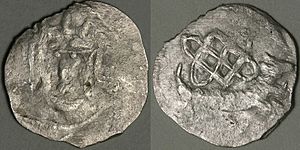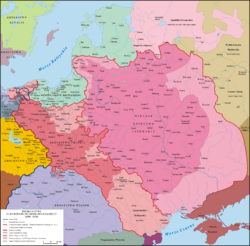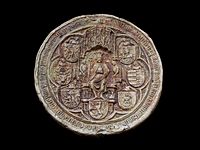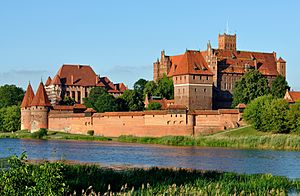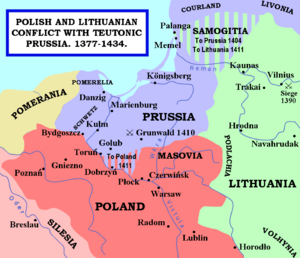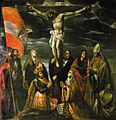Władysław II Jagiełło facts for kids
Quick facts for kids Władysław II Jagiełło |
|
|---|---|
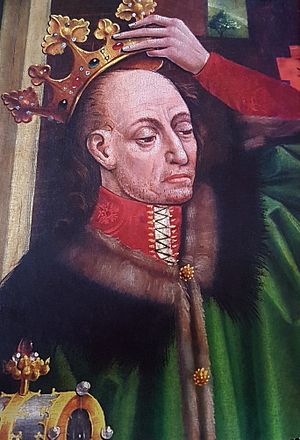
King Władysław II Jagiełło, detail of the Triptych of Our Lady of Sorrows in the Wawel Cathedral, Kraków.
|
|
| Grand Duke of Lithuania | |
| Reign | May 1377 – August 1381, 3/15 August 1382 – 1 June 1434 |
| Predecessor | Algirdas |
| Successor | |
| King of Poland with Jadwiga (1386–1399) |
|
| Reign | 4 March 1386 – 1 June 1434 |
| Coronation | 4 March 1386 |
| Predecessor | Jadwiga |
| Successor | Władysław III |
| Born | c. 1352/1362 Vilnius, Grand Duchy of Lithuania |
| Died | 1 June 1434 Gródek Jagielloński, Kingdom of Poland |
| Burial | Wawel Cathedral |
| Spouse |
|
| Issue | |
| Dynasty | Jagiellon (cadet branch of the Gediminid dynasty) |
| Father | Algirdas, Grand Duke of Lithuania |
| Mother | Uliana of Tver |
Jogaila (Lithuanian: [jɔˈɡâːɪɫɐ]; c. 1352/1362 – 1 June 1434), later known as Władysław II Jagiełło (Polish: [vwaˈdɨswaf jaˈɡʲɛwwɔ]), was a very important ruler in Eastern Europe. He was the Grand Duke of Lithuania from 1377 to 1434. He also became King of Poland in 1386. At first, he ruled Poland alongside his wife, Jadwiga, until 1399. After her death, he ruled Poland alone.
Jogaila was born a pagan, meaning he followed an old religion with many gods. In 1386, he decided to become a Catholic. He was baptized in Kraków and married the young Queen Jadwiga. Then, he was crowned King of Poland as Władysław II Jagiełło. In 1387, he helped convert Lithuania to Catholicism. His rule in Poland lasted for 35 years after Queen Jadwiga's death. He helped create the Polish–Lithuanian union, which joined the two countries for centuries.
Władysław II Jagiełło was part of the Jagiellonian dynasty in Poland, which was named after him. This family was also known as the Gediminid dynasty in Lithuania. The Jagiellon dynasty ruled both Poland and Lithuania until 1572. They became one of the most powerful families in Europe during the late medieval and early modern times. During Władysław's reign, the Polish-Lithuanian state was the largest Christian country in the world.
Jogaila was the last pagan ruler of medieval Lithuania. After he became King of Poland, the new Polish-Lithuanian union faced a strong enemy: the Teutonic Order. These knights were a powerful military group. In 1410, the Polish and Lithuanian armies won a huge victory against the Knights at the Battle of Grunwald. This battle, and the peace treaty that followed, protected the borders of Poland and Lithuania. It also showed that the Polish-Lithuanian alliance was a major power in Europe. Władysław II Jagiełło's rule helped Poland grow. It is often seen as the start of Poland's Golden Age, a time of great success.
Contents
Early Life and Rule in Lithuania
Growing Up in Lithuania
We don't know much about Jogaila's early life. Even his exact birth year is a bit of a mystery. Some historians thought he was born in 1352, but newer research suggests it might have been around 1362. He belonged to the Gediminid dynasty, a ruling family in Lithuania. His father was Algirdas, the Grand Duke of Lithuania. His mother was Uliana of Tver. Jogaila's name meant "more courageous and superior." He spent most of his early years in Vilnius, the capital of Lithuania.
When Jogaila became Grand Duke in 1377, Lithuania was a large country with different groups of people. It had ethnic Lithuanians in the northwest and vast lands of former Kievan Rus' in the south and east. These Rus' lands are now parts of Ukraine, Belarus, and western Russia. At first, Jogaila ruled the southern and eastern parts of Lithuania. His uncle, Kęstutis, ruled the northwest. This shared rule soon caused problems.
Challenges and Conflicts
Early in his rule, Jogaila had to deal with unrest in the Rus' lands. In 1377–78, his older brother, Andrei of Polotsk, challenged his power. In 1380, Andrei and another brother, Dmitry, joined forces with Prince Dmitri of Moscow. They fought against Jogaila's ally, emir Mamai of the Golden Horde. Jogaila did not help Mamai in the Battle of Kulikovo. This led to a big defeat for Mamai's army. This battle also marked the beginning of Moscow's rise to power.

In the northwest, Lithuania was constantly attacked by the Teutonic Knights. These knights were a religious military order. They were founded to fight and convert the pagan tribes in the Baltic region. In 1380, Jogaila secretly made a deal against Kęstutis. When Kęstutis found out, a civil war began. Kęstutis took Vilnius and became Grand Duke. In 1382, Jogaila gathered an army and fought Kęstutis. Kęstutis and his son Vytautas were tricked and imprisoned. Kęstutis was found dead, likely murdered, a week later. Vytautas escaped to a Teutonic fortress.
Jogaila then made a treaty with the Knights. He promised to become Christian and give them land. But he didn't keep his promise, so the Knights invaded Lithuania. In 1384, Jogaila made peace with Vytautas. He promised to give Vytautas his lands back. Vytautas then turned against the Knights.
It is known that Jogaila spoke Lithuanian with his cousin Vytautas. When he helped convert the people of Samogitia to Catholicism, he taught them himself. This shows he could speak the Samogitian dialect of Lithuanian. Some records from the Teutonic Knights say he couldn't read or write.
Becoming a Catholic and Getting Married
Jogaila's mother wanted him to marry a Russian princess. But this would mean he had to become Orthodox Christian. This would not stop the crusades by the Teutonic Knights, who saw Orthodox Christians as not much better than pagans. So, Jogaila chose another path. He accepted an offer from Poland. He would become a Catholic and marry the young Queen Jadwiga of Poland, who was only eleven years old.
The Polish nobles wanted this marriage for several reasons. They hoped to stop Lithuania from being a danger to Poland. They also wanted to gain control of fertile lands. The nobles also saw it as a chance to increase their own power and avoid influence from Austria.
On August 14, 1385, Jogaila made promises in the Union of Krewo. He promised to become Christian. He also promised to return lands taken from Poland. A key part of the agreement was to connect Lithuania and Poland forever. This was a very important agreement for both countries.
Jogaila was baptized at Wawel Cathedral in Kraków on February 15, 1386. He then started using the name Władysław. Three days later, he married Jadwiga. On March 4, 1386, he was crowned King Władysław. He was the first Lithuanian to become King of Poland. His baptism led to many people in his court and noble families becoming Catholic. Mass baptisms also took place in Lithuanian rivers, starting the final Christianization of Lithuania. This conversion had a huge impact on the history of both Lithuania and Poland. In 1387, he made a rule that Catholics could not marry Orthodox Christians. He also asked Orthodox people who had married Catholics to convert to Catholicism.
King of Poland
Starting His Reign
Władysław II Jagiełło and Jadwiga ruled together. Jadwiga was active in Poland's political and cultural life. In 1387, she led military trips to regain lands for Poland. She also started talks with the Teutonic Order in 1390. However, Władysław handled most of the political duties. Jadwiga focused on cultural and charity work.
Soon after becoming king, Władysław gave Vilnius a city charter. This was like the one in Kraków. He also gave special rights to Jewish people in Trakai. Władysław worked to combine the legal systems of Poland and Lithuania. By 1569, the two countries had very similar systems.
One result of Władysław's actions was that Catholics in Lithuania gained more power. They received special rights that Orthodox nobles did not have. This process helped create stronger Lithuanian and Rus' identities in the 1400s.
Facing Challenges
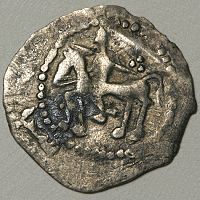
Even after Władysław became Christian, the crusades by the Teutonic Knights did not stop. They claimed his conversion was not real. They continued their attacks, saying there were still pagans in Lithuania. But it became harder for the Order to justify their crusades. They faced a growing threat from the alliance of Poland and a truly Christian Lithuania. Władysław helped create the diocese of Vilnius, a church region. This helped connect Lithuania and Poland more closely through the church.
In 1389, Vytautas again challenged Władysław's rule in Lithuania. Vytautas felt that Skirgaila had too much power. Vytautas started a civil war to become Grand Duke. In 1390, Vytautas and the Teutonic Order attacked Vilnius. Władysław's forces defended the city. The conflict ended in 1392 with the Treaty of Ostrów. Władysław agreed that Vytautas would rule Lithuania as Grand Duke until his death. However, Vytautas would still be under the Polish king. Vytautas soon tried to make Lithuania fully independent from Poland.
The long war between Lithuania and the Teutonic Knights ended on October 12, 1398, with the Treaty of Salynas. Lithuania agreed to give up Samogitia and help the Knights attack Pskov. In return, the Knights would help Lithuania attack Novgorod. Soon after, Vytautas was crowned king by local nobles. But the next year, his army was defeated in a big battle. This ended his plans for a large eastern empire. He had to accept Władysław's protection again.
King of Poland: Important Events
New Marriages and Alliances
On June 22, 1399, Jadwiga gave birth to a daughter, Elizabeth Bonifacia. But both mother and daughter died within a month. This left Władysław as the sole ruler of Poland, without an heir. Jadwiga's death weakened his claim to the throne. Old disagreements between Polish nobles started to appear. In 1402, Władysław married Anna of Celje, a granddaughter of Casimir III of Poland. This marriage helped make his rule more legitimate.
The Union of Vilnius and Radom in 1401 confirmed Vytautas as Grand Duke under Władysław. It also said that Władysław's heirs, not Vytautas's, would become Grand Duke. If Władysław died without heirs, Lithuanian nobles would choose a new ruler. This agreement created strong ties between Polish and Lithuanian nobles. It also formed a lasting alliance between the two states. This helped Lithuania in its new war against the Teutonic Order. The union also gave more power to the Lithuanian nobles.
In late 1401, the war against the Order was hard on Lithuania. Władysław's brother, Švitrigaila, started revolts and declared himself Grand Duke. In 1402, he got support from the Teutonic Knights.
Fighting the Teutonic Order
The war ended with the Treaty of Raciąż on May 22, 1404. Władysław agreed to give up Samogitia and support the Order's plans for Pskov. In return, the Knights sold Poland some disputed lands. Both sides needed time to prepare for future conflicts.
Also in 1404, Władysław met with Wenceslaus IV of Bohemia. Wenceslaus offered to return Silesia to Poland if Władysław helped him in his power struggles. Władysław refused this offer. He did not want new military duties in the west.
The Great War with the Teutonic Knights

In December 1408, Władysław and Vytautas planned their strategy. They decided to start an uprising in Samogitia against the Teutonic Knights. This would draw the Knights' forces away. Władysław promised to give Samogitia back to Lithuania in a future peace treaty. The uprising began in May 1409. The Knights did not react much at first. But by June, they warned Władysław's court not to get involved. Władysław told the new Grand Master that Poland would intervene if the Knights attacked Samogitia. This led the Order to declare war on Poland on August 6.
The castles on the northern border were in poor condition. The Knights easily captured several towns. Władysław arrived in late September and quickly retook one town. He made a temporary peace with the Order on October 8. During the winter, both armies prepared for a big battle. Władysław built a special floating bridge to move his troops.
Both sides also tried to gain allies. The Knights sent letters to European rulers, calling for a crusade against "heathens." Władysław sent his own letters, accusing the Order of wanting to conquer the world. Many foreign knights joined both sides. Wenceslas IV of Bohemia allied with Poland. His brother, Sigismund of Luxembourg, allied with the Order.
The Battle of Grunwald
The war started again in June 1410. Władysław led a large army into the Teutonic lands. His army had about 20,000 mounted nobles and many other soldiers. After crossing the Vistula River, his troops met Vytautas's army. Vytautas had 11,000 light cavalry, including Lithuanians, Ruthenians, and Tatars. The Teutonic Order's army had about 18,000 cavalry and 5,000 foot soldiers.
On July 15, at the Battle of Grunwald, the allies won a huge victory. It was one of the biggest and fiercest battles of the Middle Ages. The Teutonic Order's army was almost completely destroyed. Many of their main commanders were killed, including their Grand Master. Thousands of soldiers died on both sides.
The path to the Teutonic capital, Marienburg, was now open. But Władysław waited to advance. His army arrived at Marienburg on July 25. By then, the new Grand Master had organized a defense of the fortress. Władysław's siege of the castle was not very strong. He called it off on September 19. Historians are not sure why he hesitated. It might have been because the castle was too strong, or his army had too many losses. He might also have wanted to keep the Order weakened but not completely destroyed.
After the Battle
The war ended in 1411 with the Peace of Thorn. Poland and Lithuania did not get as much as some Polish nobles wanted. Poland got back some land, and Lithuania got Samogitia. But most of the Teutonic Order's territory remained. Władysław released many high-ranking Teutonic Knights for what seemed like small ransoms. However, the total cost of these ransoms was a heavy burden on the Order.
This outcome made some Polish nobles unhappy. They were also upset when Władysław gave Podolia to Vytautas. In an effort to gain more support, Władysław promoted some of his critics. In the Union of Horodło, signed on October 2, 1413, he made Lithuania permanently tied to Poland. He also gave Catholic nobles in Lithuania the same rights as Polish nobles. This act also said that Polish nobles could not choose a king without Lithuanian consent. And Lithuanian nobles could not choose a Grand Duke without the Polish king's consent.
Later Conflicts and Succession
In 1414, another war broke out, called the "Hunger War." The Knights burned fields and mills. But both sides were too tired from the previous war for a major battle. The fighting stopped in the autumn. Hostilities did not start again until 1419.
The Council of Constance was a turning point for the Teutonic crusades. Vytautas sent people to the council in 1415. They said they wanted to be "baptized with water and not with blood." Polish representatives argued for an end to forced conversions and the Order's attacks. As a result, the council denied the Order's request for more crusades. Instead, they gave Poland-Lithuania the task of converting the Samogitians.
In 1422, Władysław fought another war against the Teutonic Order. He defeated them quickly. The resulting Treaty of Melno finally ended the Knights' claims to Samogitia. It also set a permanent border between Prussia and Lithuania. Lithuania received Samogitia, but the city of Klaipėda remained with the Order. This border stayed mostly the same for about 500 years. However, some saw this treaty as a loss for Poland. It meant Poland gave up claims to other important lands. More fighting between Poland and the Knights happened between 1431 and 1435.
After Vytautas died in 1430, cooperation between Poland and Lithuania weakened. This gave the Knights a chance to interfere. Władysław supported his brother Švitrigaila as Grand Duke of Lithuania. But Švitrigaila rebelled against Polish rule. The Poles then took control of some lands. In 1432, a pro-Polish group in Lithuania chose Vytautas's brother Žygimantas as Grand Duke. This led to a struggle over who would rule Lithuania, which continued even after Władysław's death.
Family and Death
After Jadwiga died, Władysław married Anna of Cilli in 1402. She died in 1416, leaving one daughter:
- Hedwig (1408–1431).
In 1417, Władysław married Elisabeth of Pilica. She died in 1420 without having children. Two years later, he married Sophia of Halshany, a Lithuanian noblewoman. She had two sons who survived:
His daughter Hedwig died in 1431. This meant Władysław could make his sons by Sophia his heirs. But he had to make promises to the Polish nobility to get their agreement. This was because the Polish monarchy was elective, meaning nobles chose the king.
In 1427, some Polish nobles tried to stop Władysław and Casimir from becoming kings. They argued that the sons were not related by blood to the previous Polish ruling family.
During a trip in 1434, Władysław caught a cold and could not recover. He died in Grodek in 1434. He left Poland to his older son, Władysław III, and Lithuania to his younger son, Casimir. Both were still children. Władysław's death ended the personal union between Poland and Lithuania for a time. It was unclear what would happen next.
Legacy
Władysław is shown on the 100 Polish złoty banknote. The Jagiełło Oak, a very old tree in Białowieża Forest, is named after him. He started the tradition of royal hunting in that area. In 2021, an asteroid was officially named Jogaila, using the Lithuanian version of his name.
Images for kids
-
Władysław II Jagiełło by Jan Matejko
-
A 17th-century depiction of Władysław II Jagiełło and Jadwiga of Poland by the cross by Tommaso Dolabella
-
King Jagiello Monument, Central Park, New York
Family Tree
| Gediminas b. c. 1275 d. 1341 |
Jewna b. c. 1280 d. 1344 |
Alexander I of Tver b. 1301 d. 22 Oct 1339 |
Anastasia of Halych | ||||||||||
| Algirdas b. c. 1296 d. May 1377 |
Uliana Alexandrovna of Tver b. c. 1330 d. 1392 |
||||||||||||
| 1 Jadwiga I of Poland b. 1374 d. 17 Jul 1399 OO 18 Feb 1386 |
2 Anne of Cilli b. 1380/81 d. 21 May 1416 OO 29 Jan 1402 |
Jogaila/Władysław II Jagiełło b. c. 1351 d. 1 Jun 1434 |
3 Elisabeth of Pilica b. 1372 d. 12 May 1420 OO 2 May 1417 |
4 Sophia of Halshany b. c. 1405 d. 21 Sep 1461 OO 7 Feb 1422 |
|||||
| 1 | 2 | 4 | 4 | 4 | |||||
| Elizabeth Bonifacia b. 22 Jun 1399 d. 13 Jul 1399 |
Hedwig b. 8 Apr 1408 d. 8 Dec 1431 |
Władysław III b. 31 Oct 1424 d. 10 Nov 1444 |
Casimir b. 16 May 1426 d. 2 Mar 1427 |
Casimir IV b. 30 Nov 1427 d. 7 Jun 1492 |
|||||
See also
 In Spanish: Vladislao II de Polonia para niños
In Spanish: Vladislao II de Polonia para niños
- History of Lithuania
- History of Poland (1385–1569)
- Names and titles of Władysław II Jagiełło
- Naming citation for Jovian asteroid 202093 Jogaila
- List of Belarusian rulers
- List of Lithuanian rulers
- King Jagiello Monument
- List of Poles


